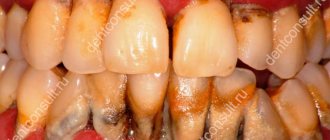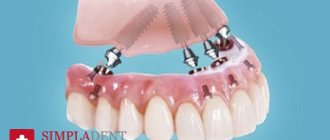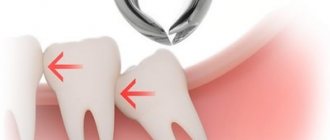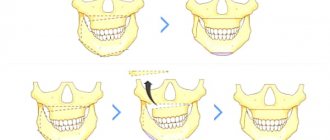The presence of milk teeth in adults cannot be attributed to the realm of fantasy or humor. This phenomenon can sometimes be encountered in dental practice. What contributes to the fact that a baby tooth can be preserved in adults and what to do with such a childhood “relic”?
Echo of childhood
Most people believe that baby teeth are closely associated with a touching and carefree childhood. It’s not for nothing that James Barry, a Scottish writer, in his fairy tale about Peter Pan - a boy who wants to always be young and not grow up - specifically describes that there were many milk pearl teeth in his mouth, and none of them had fallen out yet. Replacing baby teeth with permanent ones can be considered the same step into adulthood as the first room at school and the first two.
Teeth begin to change at about 5-6 years of age, and this process ends at about 12-14 years. Currently, according to the observations of many doctors, the replacement of baby teeth with permanent ones occurs in younger children than happened in past decades. But it also happens that baby teeth can be preserved in adults. Such cases can be encountered at 20, 30, and sometimes at 50 years of age. Why does this happen and what to do in such a situation?
Milk teeth and their features
Temporary and permanent teeth have certain differences in structure. The shape of baby teeth is the same as in molars (permanent), but their size is much smaller, the roots are shorter, and the number is different - there are only 20 of them versus 32 permanent teeth (including wisdom teeth). “Children’s” teeth are characterized by a short service life: their roots dissolve over time (as dentists say, “resorb”) approximately 2-3 years after they are fully formed. This process begins with the area touched by the crowns of the permanent teeth growing underneath them.
But it happens that for one reason or another the formation of the rudiments of permanent teeth does not occur. In this case, the roots of baby teeth are more often resorbed as a result of the influence of the rudiments of permanent adjacent teeth. But it happens that this does not happen and “children’s” teeth can then remain in adults - dentists call them persistent (translated from Latin persistere - to remain, to remain).
One day dentistry
Just a few years ago (and in some clinics even now), installing crowns took at least a month and required 4–6 visits to the dentist. Modern computer technologies make it possible to do this in 1–3 visits to the doctor. Dental impressions are becoming a thing of the past. Now, using an optical digital scanner, in 5-10 minutes the doctor receives a digitized image of the dentition, which is sent to a machine - a Triumfus multi-axis processing center (the latest development of the military-industrial complex together with dentists), on which the crown is machined automatically in 14-16 minutes. The machine can produce 200 crowns per load. The development marked the beginning of a new industry - dental machine tools. Work on it can be carried out at night and on weekends without human intervention. Thanks to this, one-day dentistry arose.
Why may there be no rudiments of permanent teeth?
There are a variety of reasons that contribute to the absence of permanent tooth buds. These include hereditary characteristics, osteomyelitis of the jaws and their traumatic lesions, metabolic disorders, pathology of the endocrine glands. In addition, acute and chronic inflammation of baby teeth, in particular, untreated periodontitis in a timely manner, can also damage the rudiments of permanent teeth and contribute to their death.
Sometimes it happens that the rudiments of permanent teeth are formed, but can lie quite deep without touching the roots of milk teeth. This may occur due to the incorrect position of the permanent tooth or lack of space. In such cases, baby teeth can also be found in adults.
Who are the enemies of implants?
Smoking reduces the lifespan of artificial teeth most significantly. Natural teeth are protected from tobacco aggression by the circular ligament and the mucous membrane attached to it, which acts as a barrier. Implants do not have such protection.
They also do not have periodontal tissue (the connective tissue surrounding the tooth), due to which their natural teeth feel pain when biting into hard food. You can bite through barbed wire with the implant without feeling any discomfort. Therefore, a person who has several implants in his mouth can periodically chew through bones, ribs, small pebbles that have fallen into food, etc. If this is done regularly, even the titanium from which they are made can collapse over time.
Do adults need to have their baby teeth removed?
Undoubtedly, baby teeth can often cause problems in adults. Firstly, their service life is short, which is why their resistance to caries is much lower compared to permanent ones. Secondly, teeth that do not fall out on time can interfere with the growth of permanent teeth and also cause them to be incorrectly positioned. But this does not mean that if a baby tooth is found in an adult, it must be removed. Everything is individual and depends on the specific situation. Very often, it is recommended to leave baby teeth in adults that are well preserved so that they last as long as they can. After all, sometimes it happens that permanent teeth may never appear in their place.
In any case, what to do with a baby tooth in adults needs to be decided after an X-ray examination is carried out, which will help determine the presence or absence of the rudiments of an unerupted permanent tooth, as well as whether the process of resorption of the baby tooth root is ongoing. If the rudiments are not found and the roots of a baby tooth have not been reabsorbed, and it looks aesthetically pleasing and immobile, then such a baby tooth should not be removed. The same applies to cases where it is X-ray proven that the position of the permanent tooth is such that even after removing the milk tooth, it will not be able to erupt. However, in this case it is better to consult an orthodontist.
Description and symptoms of the problem
The germ of a retention tooth is located in the bone, but its further growth does not occur for a number of specific reasons. This phenomenon is considered anomalous if the element has not erupted within two years from the due date.
In the partial form of the pathology, part of the crown is located above the gum or its outline is visible through the gum tissue. With complete retention, both the crown and root remain completely hidden. Typically, this problem affects the incisors, canines and the outermost “eights”. To clarify the position and shape, an x-ray examination is often required.
Typically, patients note an increase in body temperature and general malaise during teething, swelling and a change in the shade of the mucous membrane. In addition, if the element is fully formed in the bone tissue, but does not appear on the surface, pronounced pain may occur (most often it is monotonous). This indicates that the tooth is pressing on the roots of its neighbors. In some situations, facial numbness is also noted, which is caused by pressure on the nerve endings. It is also worth noting that in some cases the pathology does not provoke the appearance of any obvious symptoms.
What to do if a baby tooth can cause problems?
If you are not satisfied with the aesthetics of a baby tooth or it is mobile, you still need to start with an x-ray examination. Having discovered on an x-ray that there are no rudiments of a permanent tooth, and the roots of a baby tooth have been reabsorbed, and mobility of the 3rd - 4th degree is observed (the tooth is very mobile), then it needs to be removed and then a decision must be made about what type of prosthetics to use in this case. case.
If you are not satisfied with the appearance of the tooth, you also need to use an x-ray to determine the condition of the roots of the baby tooth and the rudiments of the permanent tooth. Further, the decision must be made individually in a specific case. It depends on the age of the patient, as well as on the place of the baby tooth in the dentition. If there are no rudiments and the roots of a baby tooth are present, a veneer can be installed on it or the tooth can be restored, making it invisible in the dentition. Those who want to completely transform their smile will benefit from Lumineers.
If there are rudiments of a permanent tooth, you need to estimate how long it will take before erupting and decide to remove the baby tooth and pull out the permanent one.
Although the presence of baby teeth in adults can be considered an anomaly, this is not a reason to part with them - after all, very often they can serve you for many years. But sometimes it happens that such “greetings from childhood” can become an obstacle to the eruption of a permanent tooth. Therefore, if you discover that you have a baby tooth, be sure to take an x-ray and consult a specialist.
How are teeth related to the health of the whole body?
It is known that horses are chosen based on their teeth. Do people have strong teeth as an indicator of excellent health?
In Asia, there is a belief that teeth are a person’s karmic knots, and the loss of a tooth is associated with damage to karma. They believe that by healing a tooth, you can restore karma.
According to the Chinese method, each tooth is associated with a specific organ. This is partly confirmed by modern research. It has been established that there are 80 diseases that are based on a source of infection located in the teeth or gums. Once inside the body with the bloodstream, the infection can lead to the development of heart and vascular diseases, and bacteria living in dental plaque can cause pneumonia.
Traditional methods of “treating” teeth. The dentist analyzed 5 popular methods Read more
Causes of supernumerary teeth.
Until now, scientists have not figured out exactly why supernumerary teeth grow.
But there are several hypotheses according to which polyodontia occurs in humans:
-As a result of splitting of the tooth germ. Polyodontia can appear if the activity of the dental plate is impaired in the fetus during the embryonic period. This can happen due to various viruses, drugs, poor ecology, as well as the mother’s abuse of bad habits and medications during pregnancy.
-Because of atavism. There is a version that polyodontia occurs because the dental system seeks to increase the number of teeth, since nature originally intended 6 incisors on each jaw.
Treatment
At an early age, treatment is aimed at actively stimulating proper growth and formation of teeth, as well as diagnosing and preventing their deformation.
Once the main 7 permanent teeth have erupted, you can begin to think about replacing missing ones. In most cases, such treatment is preceded by special preparation carried out by the orthodontist, and then subsequent procedures to restore the missing tooth.
Treatment methods:
- Dental prosthetics using metal-plastic or zirconium oxide-based crowns;
- Adhesive bridge;
- Dental implantation;
For example, with symmetrical defects (no fangs), the doctor may suggest moving the nearest teeth in place of the missing ones to replace them. It is possible to transform nearby teeth (premolars) into fangs by applying a special photopolymer-based material to them. But, in the field of dental treatment, this is aerobatics, which is not accessible to everyone. And now we are not talking about the financial situation, you also need to find an experienced doctor, namely a restorative orthodontist.
Removable prosthetics and implants will help in the fight against edentia
In case of complete secondary adentia (when teeth are completely missing), treatment methods can only be removable prosthetics or, in some cases, installation of implants. Partial secondary adentia can be treated by so-called “ orthodontic preparation ”, in simple terms - prosthetics.
How to relieve your baby's condition
Many young parents are wondering how to relieve the unpleasant symptoms that accompany the “birth” of milk units. The simplest measure is to apply cold (a piece of ice) to the “working” gum. Dental gels or ointments can also come to the rescue, relieving pain, swelling, and stopping the inflammatory process. Important: any medications should be used only with the permission of a pediatrician (pediatric dentist).
Thus, pharmacies sell special gels with lidocaine and inert fillers (menthol, astringents, flavorings) intended for use exclusively during teething. Examples of such tools:
- Kalgel (contraindicated for diathesis).
- Dentinox.
- Kamistad.
- Holisal.
- Mundizal.
General recommendations for use: a small amount of the local drug should be applied to the “working gums” 3-4 times a day for no longer than 3 days in a row.
Characteristic age-related changes during growth
Eruption of the crown means that it becomes vulnerable to external factors, which include both pathogenic bacteria and mechanical stress. The enamel and dentin layers undergo the first changes - studies show that the height of teeth decreases by an average of 0.035 mm every year, which is caused by the wearing off of the protective coating. A more intense decline is a pathological sign, as well as a consequence of the abuse of bad habits.
With age, the natural shade and structure of the enamel coating changes. Cracks and chips form, coloring pigments accumulate, and areas are formed through which plaque containing pathogenic microorganisms penetrates into the fabric. It is worth noting that the human body does not have a mechanism for regenerating tooth enamel, so any damage requires a medical examination and, if necessary, comprehensive treatment that eliminates negative consequences.
Age-related changes in the pulp
Aging also affects the internal structure of teeth. A reduction in pulp volume, as well as the formation of fibrous deposits, leads to the accumulation of minerals that worsen the condition of the internal vessels and capillaries that provide nutrition to the element. Among patients in the older age group, pulpal atherosclerosis is often diagnosed, which results in fragility and vulnerability of the teeth.
Changes in bone and gum tissue
Another characteristic sign of age-related changes is a decrease in the density of the bone tissue structure, expressed in a reduction in height, as well as the manifestation of excessive mobility of elements of the dentition. Jaw osteoporosis is considered a common pathology, affecting patients over 50 years of age. In addition, weakening of bone tissue leads to adentia - tooth loss - which results in incorrect distribution of the chewing load, leading to atrophy.
Negative processes also affect the soft tissues of the oral cavity. Gum recession, as a rule, is the result of the development of periodontal pathologies, genetic predisposition, non-compliance with medical recommendations and the presence of bad habits. Ultimately, age-related changes lead to complete tooth loss, requiring surgical dental treatment. At the same time, premature adentia can be avoided by regular visits to the doctor, which include preventive and physiotherapeutic procedures, as well as the restoration of individual lost or destroyed units.
University
DOSSIER 'KP'
Naumovich Semyon Antonovich, Doctor of Medical Sciences, Professor. 1990-1994 – Deputy Dean of the Faculty of Dentistry. In October 1991, he was elected to the position of associate professor, from 1993 to the present time he has been the head of the department of orthopedic dentistry of BSMU. Author of more than 500 scientific papers, including 9 co-authored monographs, 12 patents.
— Semyon Antonovich, is it true that Belarusians have bad yellow teeth because of chlorine water from the tap?
— Teeth are primarily heredity, genes, even how the fetus developed in the womb is important. But after birth, nutrition and lifestyle come to the fore. Health depends primarily on yourself, and only 11-12% on medicine. Environment, nutrition, lifestyle - these are the three pillars on which health rests.
In addition, dental health can be improved. The republican prevention program contains the main idea - the use of fluoride preparations, it strengthens the enamel. To strengthen teeth, fluoridated table salt is produced in Mozyr.
From 2003 to 2008, I was the chief dentist of Belarus, the main thing is that we did not destroy what was accumulated during the Soviet era: even now in kindergartens and schools, children are examined by dentists, preventive measures are carried out, they are taught oral hygiene, and, if necessary, treatment. If it weren’t for this, our dental health indicators - the KPU index: caries-filling-extracted tooth - would be much worse. Today we are leaders in the post-Soviet space.
There are WHO requirements for each age regarding the number of remaining teeth. Let's take the indicative age category of 65-74 years: the latest European requirements for this age are 20 teeth. But our indicator is quite high: in 2013-2014, Belarusians of this age had up to 15 teeth.
- Is it true that Americans have good white teeth because they eat and drink everything with ice?
— No, rather because a small filling there costs about 100 dollars. The patient is motivated to get a filling, because the next stage is a crown for $600. And if you engage in prevention from a young age, you may not have to pay.
A lot depends on the person himself: how he takes care of his oral cavity, whether he brushes his teeth correctly, chooses a brush and paste. Universal advice - which is better? - no: each has its own characteristics, it all depends on the condition of the mucous membrane and enamel.
“It happens that young people remove 15-20 teeth”
— I heard that every tooth pulled out brings a person closer to old age: they say, the brain receives a signal and rearranges its work...
— The absence of even one tooth is of great importance, especially if it is a front one. But the absence of the so-called “six” is also a problem. If the defect is not closed, the neighboring teeth begin to move, and this is due, as you say, to signals from above. Teeth can move vertically, transversely, or in any other direction - along the line of least resistance. They can also shift at an angle of 5-7 degrees. As a preventative measure, we recommend making a temporary prosthesis – popularly called “butterflies” – to close the defect so that the teeth do not move. And then decide: to make an implant or a bridge based on nearby teeth.
— But the absence of one tooth is not an indication for intervention, or would you still not advise leaving even one hole?
— I wouldn’t recommend it, especially the sixth teeth. As a rule, they are the first of the permanent teeth to appear and the first to wear out; the load on them is colossal. When they are removed, people sometimes do not pay attention and live without a tooth. And after 10 years they come to us with complaints: “Doctor, the muscles on my face hurt.” If a person has lost key teeth, deformation of the dentition begins, and the temporomandibular joints become sensitive. The absence of even one tooth will manifest itself as unpleasant symptoms within 4-7 years.
— Some people are afraid to insert implants - it’s an operation! – especially now, when the number of cancer diseases is growing. And it’s scary to put on “crowns” - they say the teeth under them rot and collapse...
— If the supporting crowns are made with high quality, there will be no damage for 8-10 years. Yes, if the crowns are made poorly - we call them “pans” - a “greenhouse effect” develops under them: food and saliva get in, which leads to tooth decay.
Implants can be installed if the patient has sufficient bone tissue, the bone structure allows for manipulation and there are no contraindications. These include diabetes mellitus, thyroid diseases, and cancer.
Another contraindication is severe forms of periodontal disease, previously called periodontal disease. This is the exposure of the gingival margin, loss of bone tissue, loose teeth, which we most often remove. With such a disease, the implantologist will also refuse you: your own tooth does not take root, how will someone else’s tooth take root? Periodontal disease - when the bone is lost, but the tooth is intact, but must be removed - this is scary. Here, first of all, professional hygiene is important: removal of dental plaque and anti-inflammatory therapy of the gingival margin. Removing visible tartar is easy, but there are also stones under the gum. Sometimes it’s so far away that you can’t take a picture right away. Then they perform a patchwork operation: they peel off the gingival margin and this is the only way to remove the stone. Otherwise, it will mechanically destroy first the gum and then the bone.
The first signs of such a problem are bleeding gums, both while brushing your teeth and without. Plus visible changes: swollen gingival margin with a bluish tint. To recognize the problem at an early stage, every self-respecting person should go to the dentist twice a year.
- But they say that exposure of the roots of the teeth is an age-related feature, no?
— Yes, but often there is also a general pathology, for example, diabetes, blood diseases, and thyroid diseases. Young people with such diagnoses come to us at both 25 and 27 years old. I write the conclusion: “Remove 15-20 teeth.” And even more! There are teeth, but there is no bone tissue where they would be fixed. The teeth move even from a “gust of wind.” As a rule, we provide prosthetics for such patients only with removable dentures.
“If a dentist enters the profession with a counter in his eyes, he will not make a good specialist.”
“But even in such situations, when all the teeth have been removed, there is no need to panic. Yes, you need to get used to removable dentures, but life goes on. Let me give you the example of my grandmother: she had full dentures made in 1933, she was only 35 years old. As a result, she lived happily for 97 and a half years, 60 of them with complete dentures. When I offered to make her new ones, she just waved her hand: “They don’t make them like that now...” But I still reconstructed them several times, since such prostheses must be remade every 5-6 years. And as a specialist, I understand well that she would never have lived this long without them...
— I have a friend who, before leaving for America about 10 years ago, made himself new teeth: he pulled out his own and inserted beautiful, white implants. Two years later, the first thing that caught my eye was how his face had changed, how it was swollen or something. He complained: his joints hurt and it was difficult to eat. Is this poor-quality work or is it rather the body’s fault that it rejects something foreign?
- More likely, both. Unfortunately, this happens. The first attempts to make implants began in Minsk at the 13th dental clinic back in 1989. I then worked as deputy dean of our dental faculty, I was appointed chairman of the commission for evaluating those first experiments. The methods were rather weak, but our specialists were trained in Vilnius. The first steps were with problems, today I understand that those implants were not installed very well...
But 26 years have passed, and today there are practically no such problems, we are among the world statistics: implants serve the patient for 9-12 years or more. Yes, it happens that patients come to us - they were promised a lot, implants were installed, then crowns were made on them, people paid a lot of money - and after a year we remove and remove everything. It happens that prosthetics are carried out with numerous errors: in the upper jaw, for example, the implant is removed into the maxillary sinus, in the lower jaw - into the mandibular canal, inflammatory processes begin. But, thank God, such cases are rare.
The best school graduates come to our dental faculty, over the last 10-15 years - with a score from 370 to 400. Previously, the medical faculty was the best, now we have practically no competitors. We train general dentists who, after graduating from university, not only have good theoretical knowledge, but also have excellent practical skills in all areas of dentistry.
— It’s logical, I heard that dentistry is the easiest way to earn good money in medicine, the main thing is to open your own private office.
— Unfortunately, I also hear about this often. But this is not such an easy bread, it is associated with occupational hazards and great psychological and physical stress. If a person enters a profession with a calculator in his eyes, he will not make a good specialist...
“We once reduced the size of the lower jaw.”
“I would never have thought that a beautiful smile can be achieved with the help of braces: a person hasn’t smiled for half his life because of ugly, uneven teeth, and then one day he starts to shine!”
— I have been dealing with this problem for almost 40 years. When I started working in the late 70s, there was only one orthodontist in the entire Minsk region. At the regional dental clinic, he saw 80 patients in 6 hours of work: 40 patients had impressions taken, 40 had ready-made orthodontic plates applied. There were no braces yet, only removable devices.
Nowadays, with the help of braces, you can manipulate your teeth and dentition quite widely: move, reduce, expand. But braces can be used when the bite is formed: no earlier than 11-13 years.
In complex cases, an integrated approach to the treatment of such patients is needed. First, they undergo preparatory surgical operations. So, for a student from Syria - his chin protruded four centimeters forward - my teacher, Professor Chudakov, and I reduced the size of the lower jaw. And only then they installed orthodontic devices, straightened the remaining teeth and completed the treatment with dentures.
—What incident impressed you the most?
“Once a LAZ driver came to me; there were buses like this that were produced in Lvov. The rotating iron handle of the starter crushed half of his face, knocking out almost all his teeth, along with the alveolar processes (the part of the jaw where teeth grow from). My teacher, Professor Velichko, and I restored his jaws and made luxurious ceramic removable dentures. Later, years later, he came and thanked them for helping him improve his life: he got married and looked great.
I also remember when I was just starting to work, a young man approached me and asked me to do his wife’s teeth. They looked and gasped: she had 28 rotten roots and not a single tooth. And she is only 25 years old! We had to remove all the remains, it was impossible to restore them, and make removable ceramic dentures. In those days, no one did implants in our country. It turned out that my husband didn’t even know what was in her mouth, and we didn’t tell him either. She was a nice girl, I remember, I also advised her: “You know, don’t take them off at night - just for hygiene - don’t let her know anymore...”
Photo: DMITRY LASKO Komsomolskaya Pravda , February 9, 2016
Why do fillings fall out?
The filling, no matter what material it is made of, is not without drawbacks. Essentially, it is glue, which in different layers has a different structure and degree of condensation. Therefore, any temperature difference in the mouth causes a change in its volume. Because of this, microcracks occur, which eventually destroy the filling.
Today, when a tooth is destroyed, dentists prefer to use inlays (prostheses shaped like the missing part of the tooth). They are made on multi-axis specialized machines (on the same Triumfus) from a solid block of zirconium dioxide or lithium disilicate, which is 2 times stronger than tooth enamel (the strongest material in the body). This design can be installed even on a completely destroyed tooth, of which only one root remains (provided that there are no cracks, remnants of old pins or inflammation in it). Using modern digital methods, this can be done in the presence of the patient in 30–40 minutes.
Or maybe a filling would be better? Debunking myths about crowns Read more
Consequences of edentia
A disease such as adentia has a huge number of negative consequences. A person is not able to clearly pronounce individual sounds, speech becomes slurred and unpleasant for others, it is very difficult for such people to find work in the field of social communications where constant communication is required. Some types of food, such as tough and hard foods, simply become inaccessible, since in order to bite off and thoroughly chew meat, you need a full set of teeth. Such a person is doomed to lifelong intake of liquid food. And if at first glance this problem does not seem so terrible, then it is worth considering it from a slightly different angle. Due to the lack of vitamins that the body must receive from solid food, after some time the patient begins to develop diseases of the stomach and intestinal tract, as well as the body as a whole. In this connection, the problem of edentia cannot be postponed until later.
The doors of YuliSTOM dental clinics in St. Petersburg are open 7 days a week!
You can both get advice and get rid of edentia in our dental clinics. Moscow metro station Zvezdnaya, Danube Avenue, 23
How do “eights” erupt?
It is impossible to give an unambiguous answer to the question of when wisdom teeth begin to grow and until what age do they grow. Third molars “come into the world” in the period from several months to 2-3 years, causing a lot of unpleasant sensations. When the “eights” begin to grow is influenced by many factors - in particular, the number of bone buds, heredity, and the anatomical features of the jaw (its shape). Due to the fact that third molars often create a certain discomfort - they affect the functioning of the TMJ, provoke sinusitis, and “displace” neighboring units of the dentition - they are often removed.
The main indications for extraction are:
- persistent hyperthermia (2–3 days) during the growth of wisdom teeth;
- acute inflammation of the gums (gingivitis) at the site of eruption;
- severe pain that makes eating difficult.
Anatomical features (shape) of the jaw, heredity and a number of other factors determine the timing of teething









